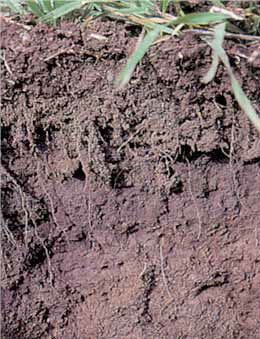What is pugging?
A dairy farmer's income is largely related to the quality and quantity of their pasture. But, with increased rains, pastures can be damaged by cows tearing up the paddock's soil structure — this is called 'pugging'.
The wetter a soil becomes, the weaker it is and the less it's able to withstand compaction and pugging. This weakness varies with soil type.
In pugged soils, the top 4cm to 8cm acts as a seal and prevents further rain from dispersing through the soil. These severely pugged areas, especially in the clay and clay loam soil types, may not fully recover until well into the second spring if not renovated or oversown.
The severity of pugging depends on factors such as:
- physical properties of soil type
- rainfall soil
- moisture content
- number and size of cows on the damaged area
- length of time they are left there
- pasture cover.
This damage can range from light, requiring little or no repair work, to very severe, needing a full resowing program.
Effect of pugging and wet weather
Pugging and wet weather can have the following effects:
- reduced pasture growth by 20 to 80 per cent, depending on pugging severity
- reduced pasture utilisation by 20 to 40 per cent
- reduced ryegrass tiller density by 39 to 54 per cent
- reduced clover content
- nutrients such as potassium, sulphur and nitrogen leached from the soil
- increased weeds and rubbish grasses in spring and the following year
- delayed spring growth — waterlogged soils use twice the amount of heat to warm 1°C compared to dry soils
- delayed and reduced silage or hay yields
- reduced nutritive value of this fodder
- uneven paddocks
- stress on farming families and animals
- major animal health problems such as mastitis, cracked teats, lameness, grass tetany and pregnancy toxaemia.
Without some form of repair, the effects of medium to severe pugging can last from several months to two years.
Effects on soil and 'micro-verse' below ground level


Pugging can affect subsoils in the following ways:
- Reduction in the number and size of the soil pores, which results in reduced soil aeration and water movement (Figure 1) compared to a well-structured soil (Figure 2). This leads to reduced pasture root activity (reduced root branching and less finer root hairs), root density, vigour and growth.
- Creation of anaerobic conditions in waterlogged soils results in the production of toxic gases such as hydrogen sulphide and carbon dioxide and the leaching of potassium, sulphur and nitrogen through the soil profile. These factors drastically affect root growth.
- Reduction in the populations of beneficial organisms such as earthworms, springtails, beetles, ants, spiders, mites, centipedes and millipedes, and other soil biota such as protozoa and nematodes.
- Long-term effects on soil organic decomposition, nutrient recycling soil structure development and resilience (for example, the ability to recover from pugging).
- Loss of nutrients via run-off from follow-up rains.
- Greater loss in pasture production than losses from compaction only.
- Greater difficulty to restore or improve soil structure.
- Soil temperatures remain at lower levels in wet soils.
Prevention of pugging (and compaction) is crucial for farmers of steep hilly country, as they can't use mechanical means to rejuvenate damaged pastures.
To recover from severely wet weather
- Cows will need to be in good condition (condition score 4.5 or above in a 1 to 8 system) at calving next autumn or spring. This may take up to 12 months to achieve if too much condition was lost.
- Pastures must be repaired as soon as possible without taking too much of the farm out of production at once. This can mean the sowing of summer crops (early to late), Italian ryegrass sowing (won't head till next season compared to annual ryegrass) and some perennial ryegrass being sown in spring (depending on rainfall). Work may not be completed on some paddocks until next autumn by being sown to pasture or winter crop after the summer crop or the existing pastures are 'thickened up' ready for autumn or winter growth.
- Farmers must be prepared for another wet winter by putting in place infrastructure or using grazing management options to protect the pasture base.
Even soils with sub-surface drainage need at least 24 hours (ideally 48 hours) to drain the water table to at least 300mm below the ground surface at the mid-point between the pipes.
Acknowledgements
This information was originally written by Frank Mickan, Ellinbank.
July 2011.